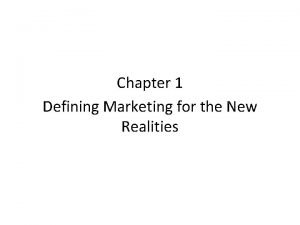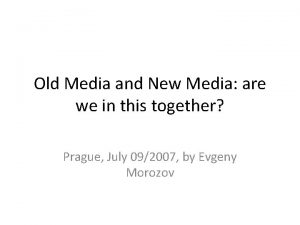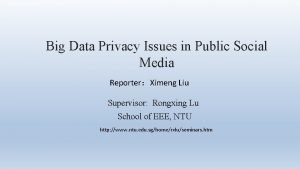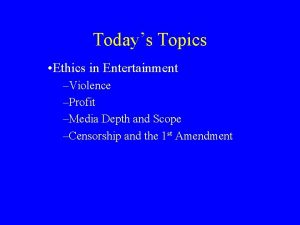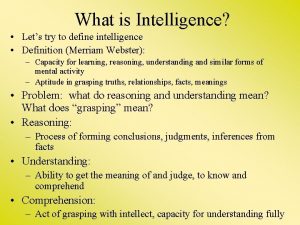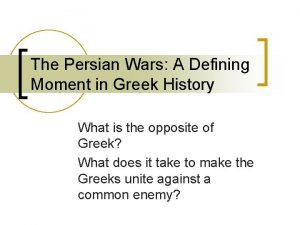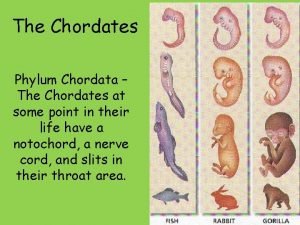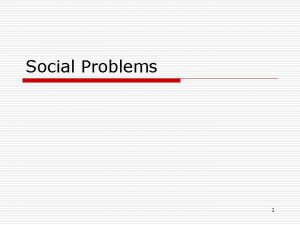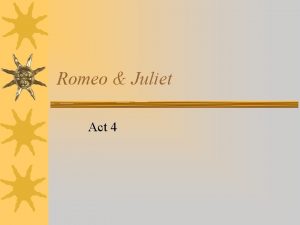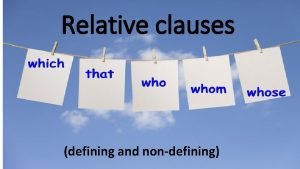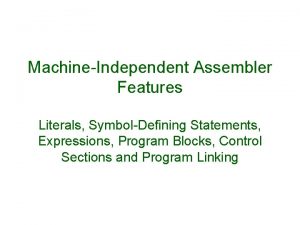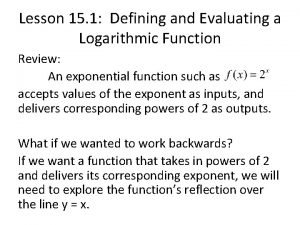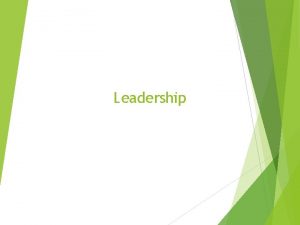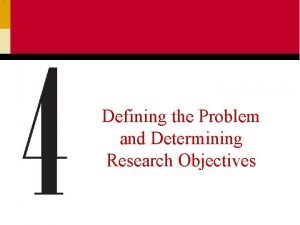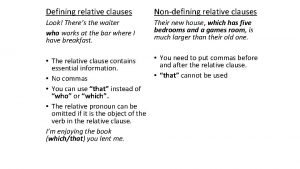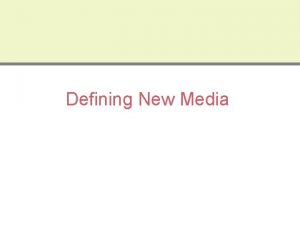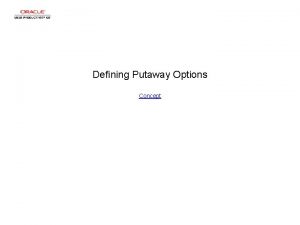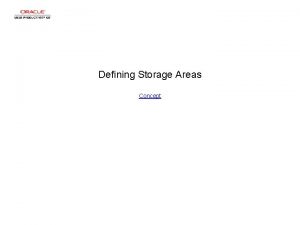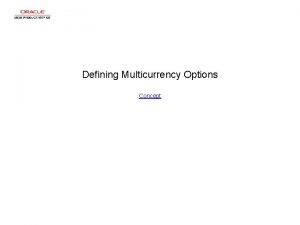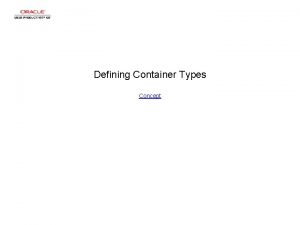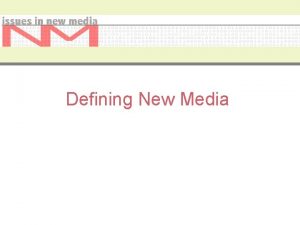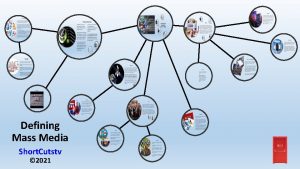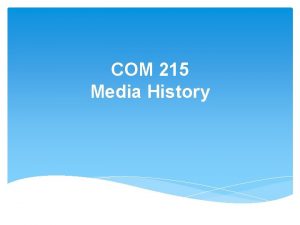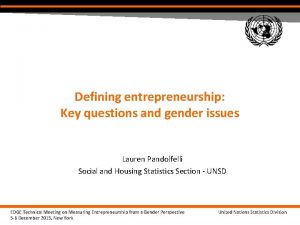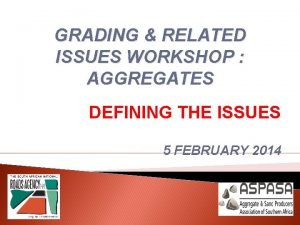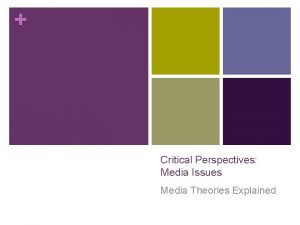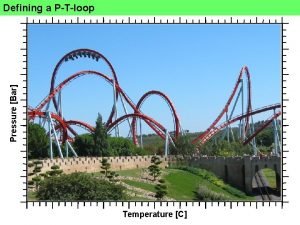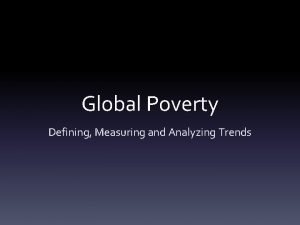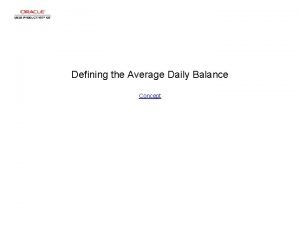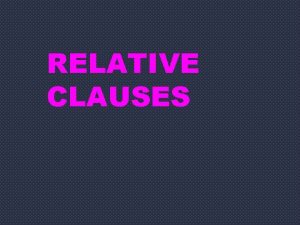Defining New Media Issues in New Media Questions


























- Slides: 26

Defining New Media

Issues in New Media • • Questions Finish Video Blogs Class Discussion Schedule – If you have powerpoints, save them on instructor computer and I will add to outline • News

Communications Media • Communications media - the institutions and organizations in which people work - press, cinema, broadcasting, publishing, online • Forms and genres of these institutions books, newspapers, films, magazines, tapes, discs, Web sites

Defining New Media • “New media” suggests something less settled, known, identified • Changing set of formal and technological experiments • Complex set of interactions between new technologies and established media forms

Change Associated with New Media • Shift from modernity to postmodernity • Intensifying processes of globalization • Replacement of industrial age by postindustrial information age • Decentering of established and centralized geo-political orders • Seen as part of technoculture - a larger landscape of social, technological, and cultural change • On a more practical level, changes associated with social and mobile technologies

Connotations of “New” • New media as “the latest thing” • Connotation of better, cutting edge, avantgarde • Social progress associated with technology • Broad cultural resonance rather than a narrow technical or specialist application • Some prefer digital media (digital binary code, 0’s and 1’s), although that symbolizes a clear break with analog media.

Kinds of New Media • New textual experiences • New ways of representing the world • New relationships between subjects and media technologies • New experiences of the relationship between embodiment, identity, and community • New conceptions of the biological body’s relationship to the technological media • New patterns of organization and production

Characteristics of New Media • • Digitality Interactivity Hypertextuality Dispersal – both as consumer and creator • Virtuality

Tim Berners-Lee • • Invented World Wide Web Wrote Weaving the Web British computer scientist Employer previously at CERN Now at MIT Director W 3 C Knighted 2004

From Pencils to Pixels • Humanists not considered in tech loop • Stages of Literacy Technology – Restricted communication function; small number of initiates – Adapted to familiar functions associated with an older technology – Decreased costs improves spread of new technology; better able to mimic ordinary forms of communication – New literacy; technology creates original forms of communication – Ultimately effects older technologies • Pencil originally used for marking measurements • Earliest forms of writing were to record business transactions, not transcribe speech

From Pencils to Pixels • Trace the stages of literacy technology for the telephone; computer; the Internet. • Do you agree with the author’s contention that “the computer is simply the latest step in a long line of writing technologies? ” • Media History Timeline

Handling Theory • • Media Determinism Social Construction

New Media: Determining or Determined? • Marshall Mc. Luhan 1911 -1980 Canadian educator technological determinism – Content of any medium is always another medium – Extensions of man – Medium is the message - real message of any medium or technology is the change of scale or pace or pattern it introduces into human affairs. – Considered patron saint of Wired

New Media: Determining or Determined? • Raymond Williams 1921 -1988 Welsh academic Social shaping of technology – Humanist frame – Plural possibilities and uses of a technology – Medium as reification of social processes – Medium as material - specific material with which an artist works – Technology becomes a medium through complex social transformations and transitions, not a given consequence of technology

Vannevar Bush • 1890 -1974 • Director of Federal Office of Scientific Research and Development • “As We May Think” appeared in Atlantic Monthly in 1945 • Considered insightful in regard to technology and human thinking processes. • Writing post-WWII, questions role of scientists in the future

As We May Think • Proposal for how scientific effort should be used in a post-war environment • Industrial revolution increased specialization • Increased information; ability to bridge disciplines • Research process is tedious and inefficient • Inability to make use of the knowledge being created • Critical of indexing systems • Recognition that human mind works by association; yet memory is transitory

Memex • Randomly named; concept rather than an actual device • “A device in which an individual stores all his books, records, and communications, and which is mechanized so that it may be consulted with exceeding speed and flexibility • “enlarged intimate supplement to memory” • Desk with screens, keyboard, buttons, and levers • Large store of information; saved on microfilm • Data could be purchased or input directly • Concept of “dry photography”; stylus input device • Access via numeric or mnemonic codes • Several projection positions; view many documents at a time • Process of tying two items together - associative indexing • Predictions of “wholly new forms of encyclopedias” with readymade associations.

Question • Bush talks about trails of association. “There is a new profession of trailblazers, those who find delight in the task of establishing useful trails through the enormous mass of the common record. ” • What is the significance of the trailblazer metaphor and what are some alternatives?

Douglas Engelbart • Born in 1925 - currently director of his own company, Bootstrap Institute which focuses on Collective. IQ. • Electrical engineer; Radar technician in Navy during WWII • Influenced by “As We May Think” • 1948 worked for NACA Ames Laboratory- precursor to NASA • Professor at Berkeley then researcher at Stanford Research Institute • Invented many defining features of computer interfaces - mouse, window, word processor

Augmenting Human Intellect • • “increasing the capability of a man to approach a complex problem situation, to gain comprehension to suit his particular needs, and to derive solutions to problems. ” – more-rapid comprehension – better comprehension – the possibility of gaining a useful degree of comprehension in a situation that previously was too complex – speedier solutions – better solutions – the possibility of finding solutions to problems that before seemed insoluble “Extensions” of means used in the past, sensory, mental, motor capability Realized associative linking - trains of thought Using computer to organize thoughts, arguments, moving text, creating relationships.

Question • Would you consider the ideas of Bush and Engelbart to be media deterministic or socially determined?

Nicholas Negroponte • Born 1943 • MIT Media Lab • Early involvement with Wired Magazine • Wrote Being Digital 1996 - ideas from his many Wired columns focused on predictions of the effects of interactive media • Most recently associated with the One Laptop Per Child Program

Being Digital • Difference between bits and atoms • The change from atoms to bits is irrevocable and unstoppable • Mass media will be refined by systems for transmitting and receiving personal information and entertainment (Epic 2015) • We will socialize in digital neighborhoods in which physical space will be irrelevant and time will play a different role • Information superhighway is about the global movement of weightless bits at the speed of light • Bits and atoms often confused (book publisher in the information business or the book production business? ) • Merits to digitization: data compression, error correction, economy of bits • Bandwidth - the number of bits that can be transmitted per second through a given channel

Being Digital • Better and more efficient delivery • Bits commingle effortlessly - mixing of audio, video, data - multimedia • Bits about other bits - headers • “If moving these bits around is so effortless, what advantage would the large media companies have over me? ” (or you? ) • Potential for new content to originate from a whole new combination of sources

Diffusion Theory • Diffusion of innovation as defined by Everett Rogers is “the process by which an innovation is communicated through certain channels over time among the members of a social system” • Elements of Diffusion • • Innovation Communication Channels Time A Social System (including opinion leaders and change agents)

Diffusion Theory Characteristics of Innovation Relative Advantage Compatibility Complexity Trialability Observability
 Defining and non defining clauses
Defining and non defining clauses Relative clauses defining and non defining
Relative clauses defining and non defining Defining non defining relative clauses
Defining non defining relative clauses Defining relative clause meaning in telugu
Defining relative clause meaning in telugu Defining non defining farkı
Defining non defining farkı Defining and non-defining
Defining and non-defining The new marketing realities
The new marketing realities Negative demand
Negative demand New media vs old media
New media vs old media Big data privacy issues in public social media
Big data privacy issues in public social media Legal and ethical issues in media
Legal and ethical issues in media Ethical issues in entertainment
Ethical issues in entertainment Professional issues in cyber security
Professional issues in cyber security Defining intelligence
Defining intelligence The defining moment in greek history is the wars
The defining moment in greek history is the wars 4 defining characteristics of chordates
4 defining characteristics of chordates Importance of textbook
Importance of textbook Romeo and juliet act 4 summary
Romeo and juliet act 4 summary Lady montague defining quotes
Lady montague defining quotes Non-defining relative clauses as sentence modifiers
Non-defining relative clauses as sentence modifiers Poverty definitions
Poverty definitions Program block and control section
Program block and control section 15.1 defining and evaluating a logarithmic function
15.1 defining and evaluating a logarithmic function Definition of leadership and management
Definition of leadership and management Research problem in research
Research problem in research Research objectives definition
Research objectives definition Non defining relatives clauses
Non defining relatives clauses






